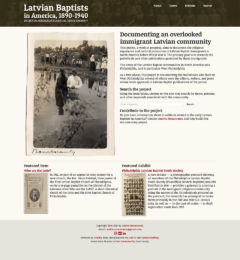In a course about digital public history through George Mason University, we have been considering the nature of audiences and how to engage with them. We also have examined shared inquiry and shared authority, which are both important concepts that pose interesting challenges.
Without a sense of which public(s) are being served, the very concept of public history falls apart. “From its earliest times, the study of history has been a public act, although different historians at different times have had different publics,” Ronald J. Grele wrote in a seminal article.1 Why history matters is a question every historian should have to grapple with, but for a public historian it is existential.
Determining how a public history project speaks to which audiences is a critical step that guides subsequent decisions. While it might not drive interpretation of historical facts, the process most certainly may — perhaps should — inform the stance of the historian. Here is where the related concepts of shared inquiry and shared authority come into play. As Katherine T. Corbett and Howard S. Miller put it, in shared inquiry “practitioners (of history) and stakeholders joined in give-and-take discussion to set mutually acceptable questions and to find mutually satisfying answers.” Shared authority, they added, “kept issues of agency — who has the power? — at the forefront.”2

One difficulty with the concepts of shared inquiry and shared authority is that I don’t see a mention of shared responsibility. By responsibility I mean not just having control, but being accountable. Authority suggests responsibility toward the research methodology, the historical interpretation, and the presentation of findings — professional and ethical concerns of the expert historian, not necessarily of the audience. If authority is shared between experts and the audience, is responsibility also dispersed? Other questions also present themselves. For example, is the sharing in shared inquiry and authority a 50-50 proposition; if not, is it really sharing? And how is shared inquiry and authority to be established and accomplished for a digital public history project for which the online environment will be used not just for presentation, but for the gathering of data? These are among the questions that will need to be dealt with as I build the Latvian Baptists in America digital history project.3
I have defined the initial primary audience for the project as the descendants of those immigrants who settled in West Philadelphia. The neighborhood was not the only place Latvian Baptists established communities in North America, but I contend it was their nexus during at least the first two decades of the 20th century. In creating a persona for this primary audience (the “amateur genealogist”), I have identified individuals who already are engaged in inquiry, and thus it could be said that I am late to the game. These are the clear stakeholders of the project, for without them, their stories, and their artifacts, the project will not evolve. While they have been focusing on family history, my concern is the larger community and its role.
In the ideal case, I would be able to sit physically at the same table with a number of these stakeholders to discuss the nature of the project and common goals, as well as to review technical requirements. However, because of scheduling and financial challenges, this may not be possible except in individual cases. For this reason, a key addition to the project website must be a presentation about how to make digital submissions that adhere to certain standards, as well as to provide a forum in which stakeholders can discuss the project’s evolution either publicly or through a private channel.
In other words, much preparatory work remains to be done.
1. Ronald J. Grele, “Whose Public? Whose History? What is the Goal of a Public Historian?,” The Public Historian 3, no. 1 (1981): 40-48.
2. Katherine T. Corbett and Howard S. (Dick) Miller, “A Shared Inquiry into Shared Inquiry,” The Public Historian 25, no. 1 (2006): 18.
3. For one perspective on some of these questions as they relate to the methodology of oral history and to historical interpretation, see Lorraine Sitzia, “A Shared Authority: An Impossible Goal?,” The Oral History Review 30, no. 1 (2003): 87-101.
Accessed on 30 Apr 2024.
The article may be found online at https://straumanis.com/2017/learning-with-the-audience/.
